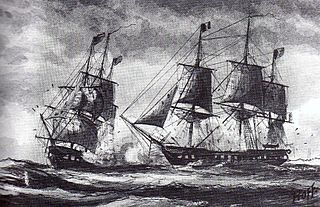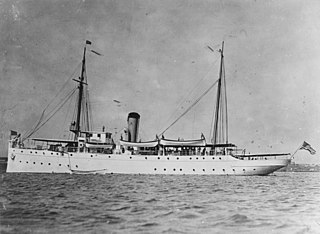USS Baltimore was a ship of the United States Navy.

The United States Revenue Cutter Service was established by an act of Congress on 4 August 1790 as the Revenue-Marine upon the recommendation of Secretary of the Treasury Alexander Hamilton to serve as an armed customs enforcement service. As time passed, the service gradually gained missions either voluntarily or by legislation, including those of a military nature. It was generally referred to as the Revenue-Marine until 31 July 1894, when it was officially renamed the Revenue Cutter Service. The Revenue Cutter Service operated under the authority of the U.S. Department of the Treasury. On 28 January 1915, the service was merged by an act of Congress with the United States Life-Saving Service to form the United States Coast Guard.
The first USS Eagle, a schooner, was built at Philadelphia, Pennsylvania, in 1798, and commissioned in the Revenue Cutter Service under the command of Captain H. G. Campbell, USRCS. She placed under control of the Navy in July 1798 for service in the undeclared naval war (Quasi-War) with France.
USS Ganges was a man-of-war in the United States Navy during the Quasi-War with France.
The first USS Montezuma was a merchant ship built in Virginia in 1795. The United States Navy acquired her during the Quasi-War with France and retained her name.

L'Insurgente was a 40-gun Sémillante-class frigate of the French Navy, launched in 1793. During the Quasi War with the United States, the United States Navy frigate USS Constellation, with Captain Thomas Truxtun in command, captured her off the island of Nevis. After her capture she served in the United States Navy as USS Insurgent, patrolling the waters in the West Indies. In September 1800 she was caught up in a severe storm and was presumed lost at sea.

USS Pickering was a brig, the 1st brig built for the UCRC Service, in the United States Revenue Cutter Service and then the United States Navy during the Quasi-War with France. She was named for Timothy Pickering, then the Secretary of State.
The first USS George Washington was a frigate in the United States Navy. She was named after United States Founding Father and President George Washington.
The second USS Delaware was a ship which served in the United States Navy during Quasi-War with France.
USS Merrimack, was a ship launched by an Association of Newburyport Shipwrights and presented to the Navy in 1798. She was the first ship of the Navy to be named for the Merrimack River. She saw action in the Quasi-War.
USRC Argus was one of the first ten cutters operated by the United States' Revenue Cutter Service. Of the ten cutters, she was the longest to serve in this role.
USRC Diligence was one of the first ten cutters operated by the United States' Revenue Cutter Service.
USRC South Carolina was one of the first ten cutters operated by the United States' Revenue Cutter Service.

USCGC Tampa (ex-Miami) was a Miami-class cutter that initially served in the U.S. Revenue Cutter Service, followed by service in the U.S. Coast Guard and the U.S. Navy. Tampa was used extensively on the International Ice Patrol and also during the Gasparilla Carnival at Tampa, Florida and other regattas as a patrol vessel. It was sunk with the highest American naval combat casualty loss in World War I.
USS Richmond was a brig purchased for the US Navy in 1798 by the citizens of Richmond, Petersburg, Manchester and Norfolk, Virginia, while being built at Norfolk as Augusta for a Mr. Myers. Renamed Richmond, she was fitted out in the fall of that year and in December stood out from Hampton Roads for the Caribbean with Captain Samuel Barron in command for service in the Quasi-War with France.

HMS Lynx was a 16-gun ship-rigged sloop of the Cormorant class in the Royal Navy, launched in 1794 at Gravesend. In 1795 she was the cause of an international incident when she fired on USRC Eagle. She was at the Battle of Copenhagen in 1801, and during the French Revolutionary and Napoleonic Wars took numerous prizes, mostly merchant vessels but also including some privateers. She was also at the second Battle of Copenhagen in 1807. She was sold in April 1813. She then became the whaler Recovery. She made 12 whaling voyages in the southern whale fishery, the last one ending in 1843, at which time her owner had her broken up.
USRC Scammel or sometimes referred to as Scammel II was a revenue cutter built in 1798 to serve in the Quasi-War with France. After completion she was transferred to the U.S. Navy and served in the West Indies naval squadron commanded by Commodore John Barry. While in Revenue-Marine service her captain was John Adams. In a letter dated 20 May, 1799 Navy Secretary Benjamin Stoddert notified the Treasury Secretary that he should consider her to be officially transferred to the U.S. Navy. In U.S. Navy service her first captain was Lieutenant Commander Fernald. She assisted the sloop USS Portsmouth in the capture of the French ship Hussar. After the war, the Navy retained Scammel until it was sold in 1801.
USRC Virginia was a schooner built in 1797 for the United States Revenue Cutter Service at Portsmouth, Virginia. At the outset of the Quasi-War in 1798, the only ships available to the Navy were the 10 ships of the Revenue cutter service, the largest of which was the Virginia. She was transferred to the Navy in 1798 and served in the Quasi War until 1800, when she was returned to the Revenue Cutter Service, recommissioned in 1802 and sold in 1807.
USRC General Green was a cutter operated by the U.S. Revenue Cutter Service. She was named for the Revolutionary War hero Major General Nathanael Greene.
USRC Diligence was a cutter operated by the United States' Revenue Cutter Service.





